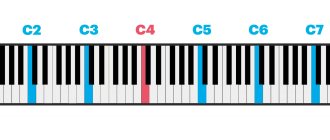All professional singing voices have a broad classification, while earlier, during the formation and development of a vocalist’s skill, it was quite simple, and was divided into only four types of voices - contralto and soprano for women, and bass and tenor for men. By and large, the same division system is still used today, but the range of voices has expanded significantly, and intermediate voices have emerged.
Range is how many notes you can hit, from low to high, without falling into falsetto or going out of tune by trying to lower your voice further than you can handle. Knowing your range, you can choose a successful repertoire that will favorably emphasize the beauty of your timbre.
Types of female singing voices
Female voices are divided into two groups - soprano and contralto. High voices (soprano) are divided into:
- Coloratura, or lyric-coloratura , is the highest of female singing voices;
- Lyric - a voice of a soft, gentle timbre, a common type, some call it the “basic” for a soprano group;
- Lyric-dramatic - a voice that has great mobility and variability in performance, the owners of which can “pull out” both the parts of lyric and dramatic soprano;
- Dramatic - a rare voice that has a range from mezzo-soprano to coloratura;
- Mezzo-soprano - characterized by a rich, deep sound, it is sometimes confused with a dramatic soprano, a type of voice that has absorbed the characteristic features of both contralto and soprano.
Examples of soprano sound
- Opera
- Variety
- Mezzo-soprano
- Contralto is the lowest of female singing voices, rich in deep sound throughout the entire range.
COUNTERTENOR
The highest male voice type, approximately equal in height to a mezzo-soprano. Countertenors were popular in the 17th century, but fell out of fashion until the mid-20th century, roughly coinciding with the boom in popularity of Baroque and other early music. The range of the countertenor is approximately from C minor octave to E second octave for altoists (lower countertenors) and approximately from G minor octave to F second octave for sopranists (higher countertenors). The male voice reaches this height by singing in falsetto.
Eric Kurmangaliev - Delilah's Aria (fragment)
In opera, countertenors mainly perform baroque roles, especially those originally intended for castrati. However, this type of voice has been taken up by some modern composers and is increasingly used in modern opera, the most famous of which is Britten's A Midsummer Night's Dream with the Elf-Lord Oberon.
Types of male singing voices
Among men, these are tenor, baritone and bass groups. Among the tenors (high voices) we can distinguish:
- The countertenor is a rare, very high voice, it is quite easy to confuse it with a female soprano without seeing the performer;
- Tenor altino is the highest (with the exception of countertenor) of male singing voices;
- Lyric – analogous to the lyric soprano, has the same soft timbre and sound; Characteristic - a unique voice, used, as a rule, in operas and productions, having many characteristic touches that create an idea of the personality of the character being represented;
- Lyric-dramatic - can perform the roles of both lyric and dramatic tenor with equal ease;
- Dramatic - a voice that has greater strength and dramatic coloring than a lyric-dramatic tenor.
Tenor sound example
Baritones (considered an intermediate voice between bass and tenor) are divided into:
- Lyric - close in sound to tenors, but still having a baritone coloring, voice;
- Lyric-dramatic - the brightest voice in color and sound among baritones, whose owners can perform parts of both a lyrical and dramatic nature;
Dramatic - the strongest, deepest of this type of voices, having a gloomy coloring.
Examples of baritone sounds:
- Opera baritone
- Variety baritone
Bass (low voices) are divided into:
- High bass, or cantante (also called “singing”) - has a light sound, easily confused with a baritone;
- Central - deep voice, pronounced bass character with great possibilities, may be somewhat dull in the upper register;
- Low (profundo), or “bass-octavist” - a rare, very low, chesty, deep voice.
The lowest bass in history made it into the Guinness Book of World Records by producing a note that sounded eight octaves lower than the lowest note on a piano! This sound can only be heard by large animals or humans, provided that special equipment is used.
BARITONE
An average male voice, singing in a range from approximately G-A of the major octave to G-1 (sometimes higher).
Lyric baritone
This is a light, rich male voice. They gravitate toward comic roles, but in some cases they are not without depth. Papageno in Mozart's The Magic Flute is an example of a lyric baritone.
Verdi baritone
The Verdi baritone, as one might expect from the name, is a voice type characteristic of Verdi's operas. True Verdi baritones are somewhat rare, these are roles that require the singer to sing notes at the extremes of the baritone range and do so with a rich, round sound. Verdi took Shakespeare's Macbeth and turned it into a thrilling opera, with a baritone playing the title role.
E. Bastianini sings “Eri tu” from the opera “Un ballo in maschera” by Verdi
Dramatic baritone
The lowest baritone, having a range similar to that of Verdi's singers, but the tessitura tends to be lower. Scarpia from Puccini's Tosca is a prime example of this voice.
How to determine your own voice timbre?
Independently determining the type of your own voice is a rather difficult task. The main difficulty is that the distinctive features of each type appear as the voice develops. If a person has never practiced vocals before, then it is difficult for him to determine his voice, his range at this moment is too narrow.
Based on this, a person first needs a chant. You need to pay attention to the notes and which ones sound better. It will also help to determine the range extension, after which you can compare it with the ranges of all major voice types.
There are also various applications for smartphones, the function of which is to determine the type of voice based on the user's listening. They can help a person understand their voice a little better, but they are not even close to replacing a lesson with a professional teacher.
Voice classification
There are many classification systems for operatic voices. This page provides an average summary classification by range. In fact, this is the German system Fach [fach], which literally means “subject, compartment, department,” that is, it means the division of voices into types. This system is widely used in Europe and is known throughout the world.
"Keep calm and find your voice type"
How does a teacher determine your voice type?
If we are talking about classes with a teacher, then we can put forward four criteria for determining the type of voice:
- Firstly, this is the timbre, which is the individual coloring of a person’s voice;
- Secondly, there is the range mentioned above;
- Thirdly, it is the key in which it is easier for a person to sing;
- Fourthly, this is tessitura - pitch load on the voice.
As a test, the teacher can start playing the lower and then the upper limit of the range, as well as its middle. The student's task is to try to repeat the notes. For example, he can repeat them while humming the sound “m”.
You can also determine your voice by the length of your vocal cords. The voice is higher if the chords are shorter. For a soprano, for example, the length of the chords is in the region of ten to twelve millimeters, and for a bass it is twenty-three to twenty-four millimeters.
BASS
Few basses are not compared to Fyodor Chaliapin.
The deepest voice of all. The standard general range of operatic basses is from major octave E to first C E. Some bass singers can go even lower, although this is rarely required in standard operatic repertoire.
Bass-baritone
A bass-baritone can sing as low as a bass, but is also comfortable in a higher tessitura, close to the baritone's range. This voice type has emerged as such since the mid-19th century, but several roles in Mozart, written in an era when the baritone had not yet become a distinct vocal type, are usually given to singers of this class. An example is Rachmaninov’s Aleko or Mozart’s Figaro.
Bass buffo
Bass buffo roles are funny, comic characters that are often found in works of the Bel Canto era. These are very different parts with extensive requirements for patter singing and mastery of the art of recitative. There are also villainous but funny heroes, for example Don Magnifico from Rossini’s “Cinderella”. By the way, buffo is divided into lyrical (Don Pasquale by Donizetti, for example) and dramatic (Danad from “The Flying Dutchman” by Wagner).
G. Taddei - The Exit of Dulcamara from Donizetti's "Elisir of Love"
Tips and exercises for low voices
First some tips:
- Watch the pace of your speech. The faster you speak, the higher your sound becomes. This affects the tension of the vocal cords.
- Breathe through your nose. Proper breathing helps relieve psycho-emotional stress and lower the tone.
- Get enough sleep. Good sleep relaxes the vocal apparatus and allows you to deepen your voice.
- Correct posture and a relaxed spine will help develop a deep voice. A straight back is a sign of a confident person. And this personality quality has a great influence on the strength of the voice and its sound.
- The position of the larynx directly affects whether you speak in a low voice or not: the lower the larynx, the more realistic it is to make the timbre lower. Therefore, show persistence and perseverance in training the neck muscles that move the larynx, learn to control them.
- Stop smoking. Often, to make their voice lower, girls resort to this trick. Nicotine really makes the timbre rougher. But chesty sound and velvety tone can never be achieved with its help.
- Sometimes, in order to make a man’s voice lower, you need to visit an endocrinologist and eliminate hormonal imbalance in the body. The pitch of the sound directly depends on the level of testosterone.
- You can achieve your goal quickly. This is for those who are haunted by the desire to quickly change and make their sound different.









